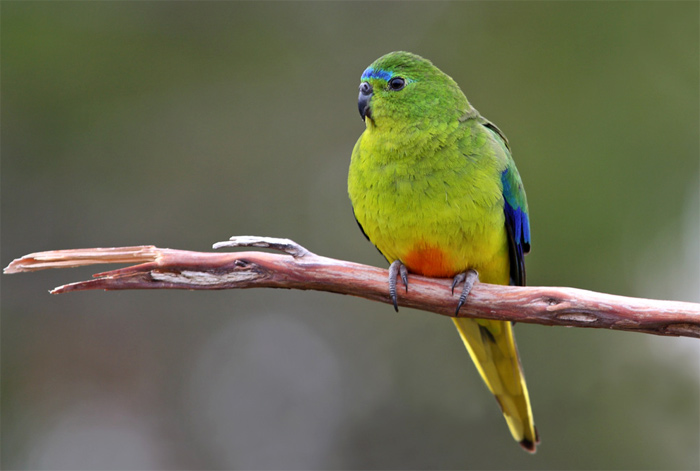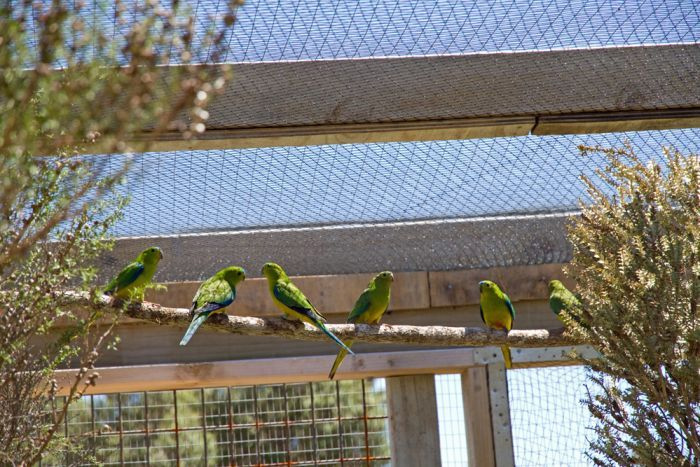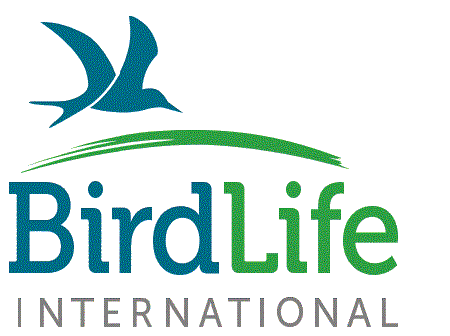Critically Endangered parrots killed by rats at breeding facility

Captive breeding efforts to save the Critically Endangered Orange-bellied Parrot Neophema chrysogaster - Australia’s rarest bird with perhaps as few as 50 individuals in the wild - have suffered a major setback.
Fourteen Orange-bellied Parrots were killed by rats during late 2015 at the Taroona (Hobart) captive-breeding facility, which is run by Tasmania's Department of Primary Industries, Parks, Water and Environment.
The affected birds were being held separately in quarantine from the main breeding stock, as they were suffering from Psittacine Beak and Feather Disease (PBFD). Following the killing of two parrots during October and November, in early December a more serious incident led to the death of the remaining birds. (In May 2013 two Orange-bellied Parrots in the same facility were killed by a cat that breached the perimeter fence.)
The Australian Federal Environment Minister, Greg Hunt, labelled the latest incident as "deeply disturbing", prompting Matthew Groom, Minister for Environment, Parks and Heritage for Tasmania to defend his government department: "The deaths of birds within the captive population has been taken seriously by the Tasmanian Government.” He stated that he has been assured that since the incident security standards at Taroona have been significantly enhanced.
Paul Sullivan, Chief Executive of BirdLife Australia commented: "These incidents clearly show the danger of allowing wild bird populations to decline until they rely on captive insurance programs. It’s tragic to lose any Orange-bellied Parrots; we need to learn from the incident and pull together to keep this bird from going extinct."

BirdLife Tasmania has called for a wide-ranging enquiry into the deaths of the parrots. Its Secretary, Sue Drake, said: "Clear transparency on the management of the Orange-bellied Parrot crisis is needed if we are to save this bird."
Orange-bellied Parrot is a small, attractive ground-feeding parrot, slightly larger than a Budgerigar Melopsittacus undulatus, with rich-green plumage and a small patch of orange on its belly that gives it its name.
The parrot is known to breed at just one site, Melaleuca in the south-west of Tasmania, before migrating to the Australian mainland to winter on saltmarshes in Victoria and South Australia (historically, the species has also been recorded from New South Wales).
Since 2005, when the wild population was estimated at around 150 individuals, the species has undergone a rapid decline, with surveys in 2010 finding fewer than 50 birds at Melaleuca, and no birds at other historical breeding sites. The main reason behind the decline is thought to be the fragmentation, degradation and loss of the species’ wintering mainland habitat as a result of increased grazing, agriculture and urban/industrial development. With such a small, remnant population the species is also susceptible to disease; an outbreak of PBFD in 2015 affected 19 out of 26 wild Orange-bellied Parrot nestlings tested. Other threats include invasive mammalian predators such as foxes and cats, competition from introduced birds including Common Starling Sturnus vulgaris, and degradation of breeding habitat in Tasmania.
To try and mitigate these declines there is a well-established captive-breeding programme, with just over 200 Orange-bellied Parrots held at various facilities on Tasmania and the mainland as of July 2012. The aim is to grow this to at least 350 birds by 2016–17.
More-promising news has recently come from the wild population at Meleleuca, where 21 birds had returned by the end of October 2015, including two birds ringed as fledglings at the site in 2014 – indicating that they had successfully undertaken their arduous migration for the first time.
BirdLife International
09 January 2016
Update: 11/01/2016
I refer to the article published by Birdlife International 9th January 2016 “Critically Endangered parrot killed by rats at breeding facility” and wish to take the opportunity to update and clarify some points for your readership.
The deaths of captive Orange-bellied Parrots to rats is the first time this has occurred in three decades of keeping this species in Tasmania. This is despite having occasional rat infestations, which until now, were kept under control with standard rodent management procedures. The unfortunate death of 14 Orange-bellied Parrots is unprecedented and has highlighted a serious lack of expertise and basic maintenance of the infrastructure. In this instance, rats have somehow managed to enter aviaries over several months to actively hunt and kill birds. In contrast, the 2013 incident when a cat killed two Orange-bellied Parrots, this did not involve the predator entering the aviary. The cause of death in this case was by head trauma through the cat climbing on the outside of the aviary and disturbing the birds at night. This was quickly remedied by removing the culprit and installation of electric wires to prevent further disturbances.
The article states that degradation of the breeding habitat is one of the threats to this species. There may of course be some subtle changes in the environment, such as through climate change, which may be impacting on the Orange-bellied Parrot but, to our knowledge, the entire breeding range is in relatively good health. The Orange-bellied Parrot only breeds within the South West National Park which is part of the Tasmanian Wilderness World Heritage Area and therefore is afforded maximum protection, with very little human pressure. However, it is true to say that habitat degradation along the species’ non-breeding migratory corridor on Tasmania’s north west coast and Bass Strait islands, combined with landscape scale habitat changes in wintering areas along the Victorian and South Australian coastline, have had a significant impact over the years on the viability of this species.
Despite the various setbacks and difficulties of breeding this species as part of the cooperative captive insurance program, the captive population reached 345 individuals at the last census in May 2015. The deaths by rats, combined with the death of 13 individuals at Healesville Sanctuary from a mystery illness and natural attrition across the captive population throughout the year, will have an impact on our ability to reach and sustain the minimum 350 target. Captive management will always have unpredictable setbacks, from diseases to poor breeding success from year to year – it is therefore crucial that predictable and avoidable causes of mortality such as by rat predation are not left to chance, particularly when significant public funds are involved.
Mark Holdsworth
President, Friends of Orange-bellied Parrot (WILDCARE Inc.)
11 January
With over 30 years experience with the Orange-bellied Parrot recovery program, Mark Holdsworth is regarded as the world’s leading expert on the species breeding biology and he his work included management of the Taroona captive facility until 2013. He is now the President of the Friends of Orange-bellied Parrot, a not-for-profit group involved in volunteer support for the Recovery Program, and he is a long-standing member and past Chair of the National Recovery Team. His commitment to the recovery of this species was recognised in 2012 with the awarding of one of four Tasmanian State finalists for Australian of the Year.






